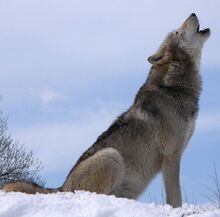
The grey wolf (Canis lupus), or just wolf, is a mammal of the order Carnivora, and the ancestor of the domestic dog. It is sometimes called timber wolf. A recent study found that the domestic dog is descended from wolves tamed less than 16,300 years ago south of the Yangtze River in China.
There are many different wolf subspecies, such as the Arctic wolf. Some subspecies are listed on the endangered species list, but overall, Canis lupus is IUCN graded as 'least concern'.
Appearance[]
Adult wolves are usually 1.4 to 1.8 metres (4.6 to 5.9 ft) in length from nose to tail depending on the subspecies. Wolves living in the far north tend to be larger than those living further south. As adults they may weigh typically between 23 to 50 kilograms (51 to 110 lb). The heaviest wolf recorded weighed 86 kilograms (190 lb).
Wolves usually measure 26–38 inches at the shoulder. Wolves have fur made up of two layers. The top layer is resistant to dirt, and the underlayer is water resistant. The color of their fur can be any combination of grey, white, red, brown, and black. Studies have shown that in 2007 they have found 23 red gray wolves.
Life[]
Wolves live in groups called "packs". They are pack hunters. The members of the pack are usually family members, often just the parents and offspring. Wolves that are not family may join if they do not have a pack of their own. Packs are usually up to 12 wolves, but they can be as small as two or as large as 25. The leaders are called the parent (breeding) male and the parent (breeding) female. Their territory is marked by scent and howling; they will fight any intruders. Young wolves are called 'pups' or 'whelps'. Adult females usually give birth to five or six pups in a litter.
Wolves make a noise called a howl. They howl to communicate with each other from long distances and to mark the edges of their territory. Wolves have a complicated body language.
Wolves can run very fast and far. A wolf can run 20-30 miles in a day.
Grey wolves can live six to eight years. They can live in captivity for up to 17 years.
Diet[]
Wolves are carnivores and eat mostly medium to large size hoofed animals (ungulates), but they will also eat rodents, insectivores and foxes. Some wolves have been seen eating salmon, seals, beached whales, lizards, snakes and birds. They also eat moose, bison, deer and other large animals. Wolves usually stalk old or sick animals, but they do not always catch what they stalk. They may go days without food. Sometimes only one out of twelve hunts are successful. But the way they eat stays the same. The alpha male and female feed first. Then the other members feed. Sometimes (especially if the prey they have killed is large) wolves may store food and come back that day to feed on it. Wolves have very sharp teeth which helps them tear large chunks of meat from a dead animal. They will eat up to 2/7 their body weight. Wolves will also swallow food and then bring it back up for pups to eat.
Habitat[]
Wolves are found in Europe, Asia and North America. They can live in forests, deserts, mountains, tundra, grasslands and sometimes around towns and cities.
Wolves and humans[]
Even though many people think that wolves are terrible, mean creatures, they are actually much gentler than many people imagine. The main reason wolves become violent is because they may be sick or to protect other wolves in the pack. Many people around the world, especially in Canada and Alaska, have huskies for pets: they are a close relative of the wolf.
A few years ago wolves were put back into Yellowstone National Park in Wyoming to breed, because they were becoming endangered. The wolves have been very successful in the park. There had been no wolves there for a long time, because of hunting and poisoned water. Many people were not happy about this because they were afraid that the wolves would eat the sheep and cows near the park. However, wolves only eat livestock when they can not find wild prey.
Extinction in Britain[]
Wolves in Britain were all killed after centuries of hunting. The last wolves survived in the Scottish Highlands. There is a legend that the last one was killed there in 1743 by a character called MacQueen.
Within the past ten years, there have been studies that are in favour of allowing new wolves to come and live in the English countryside and Scottish Highlands again. One study was in 2007. Researchers from Norway, Britain, and Imperial College London decided that wolves would help add back plants and birds that now are eaten by deer. The wolves would keep the deer population lower. People were generally positive, but farmers living in rural areas wanted to be paid for livestock that were killed by the wolves.
In culture[]
Many folktales such as Little Red Riding Hood have wolves in them.
















